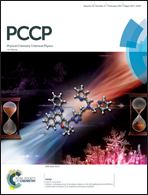Insights into the mechanism of electrochemical ozone production via water splitting on the Ni and Sb doped SnO2 catalyst†
Abstract
The H2O splitting mechanism is a very attractive alternative used in electrochemistry for the formation of O3. The most efficient catalysts employed for this reaction at room temperature are SnO2-based, in particular the Ni/Sb–SnO2 catalyst. In order to investigate the H2O splitting mechanism density functional theory (DFT) was performed on a Ni/Sb–SnO2 surface with oxygen vacancies. By calculating different SnO2 facets, the (110) facet was deemed most stable, and further doped with Sb and Ni. On this surface, the H2O splitting mechanism was modelled paying particular attention to the final two steps, the formation of O2 and O3. Previous studies on β-PbO2 have shown that the final step in the reaction (the formation of O3) occurs via an Eley–Rideal style interaction where surface O2 desorbs before attacking surface O to form O3. It is revealed that for Ni/Sb–SnO2, although the overall reaction is the same the surface mechanism is different. The formation of O3 is found to occur through a Langmuir–Hinshelwood mechanism as opposed to the Eley–Rideal mechanism. In addition to this the relevant adsorption energies (Eads), Gibb’s free energy (ΔGrxn) and activation barriers (Eact) for the final two steps modelled in the gas phase have been shown, providing the basis for a tool to develop new materials with higher current efficiencies.



 Please wait while we load your content...
Please wait while we load your content...